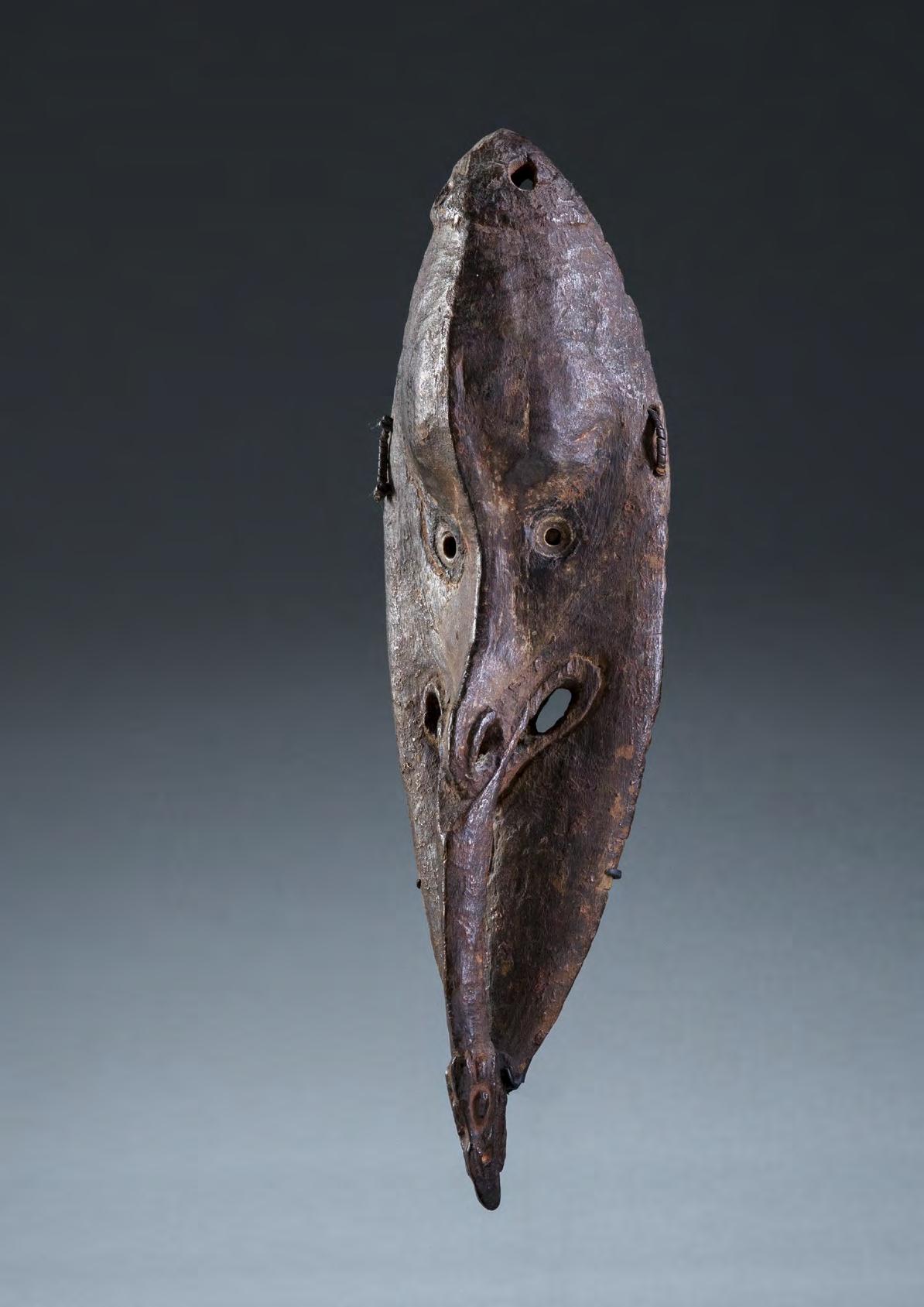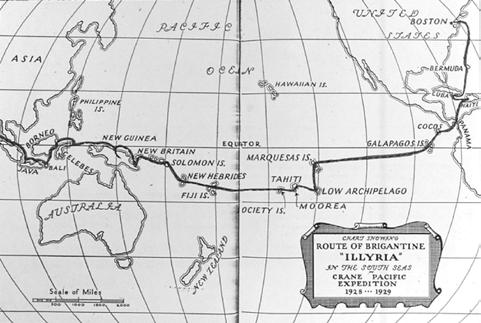
10 minute read
Two Days in May 1929 on the Keram River
Virginia-Lee Webb, Ph.D.
The Crane Pacific Expedition was an around-the-world scientific journey lasting eleven months. It began in Boston on November 16, 1928, and returned to port in the United States on October 21, 1929.
Advertisement
The voyage got its name from the Crane family of Chicago, Boston, and Ipswich, who initiated the project and provided financial support. Richard Teller Crane Jr. (1873–1931) was head of the family and the Crane companies founded by his father. Richard was married to Florence (1871–1949), the daughter of Harlow Higinbotham who had been president of the World Colombian Exposition in Chicago in 1893. Richard and Florence had two children, a daughter also named Florence (1909–1969) and a son named Cornelius Vanderbilt Crane (1905–1962). It was Cornelius who provided the idea for the expedition and who would be its leader. The Crane family was philanthropic and supported the advancement of science, and Richard was a member of the Board of Trustees of the Field Museum, Chicago. In 1927, Cornelius was given a custom-built seafaring yacht named Illyria. Because of the family affiliations with the Field Museum, Cornelius presented the idea of a scientific expedition to the Museum’s director, who enthusiastically supported the idea. Thus, the Museum would receive the collections gathered on the expedition, and several staff members were invited to participate.
The type of voyage Cornelius proposed was ideal for the Museum and would benefit several areas of research. Although Cornelius had philanthropic and scientific goals, a primary objective of his tour du monde was to visit the South Seas. He decided to mirror his multidisciplinary expedition after the routes taken by Charles Darwin in 1831 and by Darwin’s “co-evolutionist” Alfred Russell Wallace, who traveled to the East Indies in the 1850s. Cornelius was aware of the Field Museum’s prior scientific expeditions that went to the Pacific before him, especially the expedition to the island of New Guinea and surrounding islands by A.B. Lewis on the Field Expedition of 1909–1913.
After discussions with D.C. Davies, the director of the Field Museum, the preparation for the voyage began. Agreements, itineraries, and collecting priorities were set. As leader and sponsor of the expedition, Cornelius carefully selected the professionals and colleagues to accompany him. He required each individual be an expert in an appropriate scientific subject and be a “complete
Route of Crane Pacific Expedition
Cornelius Crane on Illyria
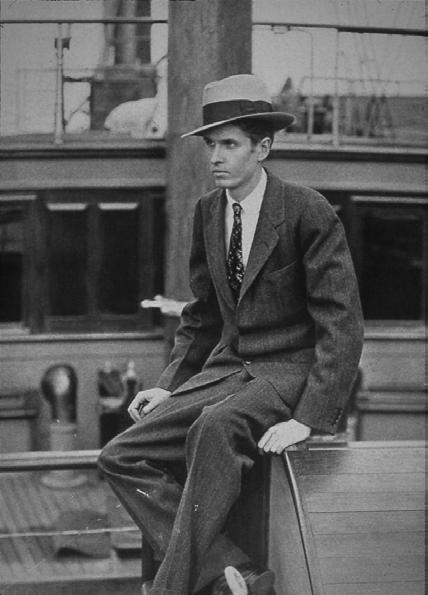

gentleman.” Cornelius was determined to assemble a congenial and academically superior group, and he wanted people who could work together at sea for nearly a year.
Sidney N. Shurtleff of Boston was Cornelius’s first choice to participate. Cornelius and Sidney were childhood friends in Ipswich. However, around the time of the expedtion Sidney’s family changed their name to Shurcliff. Sidney was appointed the official expedition photographer. Cornelius invited his friend, Charles R. Peavy of Mobile, Alabama, who had attended Harvard and had sailing experience. Murry Fairbank was a pilot and mechanical engineer, and he proved to be a versatile and valuable member of the crew. Dr. William Lorenzo Moss from the staff of Johns Hopkins, Harvard University, and Boston Children’s Hospital was an ideal candidate. He’d received his medical training at the University of Georgia and did graduate work in Berlin. In 1916, he accompanied a Peabody Museum–Harvard University-sponsored expedition to Peru. His expertise in epidemiology, tropical medicine, and his prior travel experience made him the ideal choice as physician to the expedition. The first scientist recommended by W.H. Osgood, head of the Zoology Department at the Field Museum was his assistant curator, Karl Patterson Schmidt, an expert herpetologist. Frank Wonder was then selected by Schmidt to be his assistant taxidermist. Walt A. Weber, an artist studying at the University of Chicago, was recruited to help Wonder prepare all the specimens and to make drawings of the diverse flora and fauna. The final member of the scientific team, an ichthyologist, took a bit longer to find because there was nobody qualified at the Dr. Albert William Herre Field Museum. But upon the recommendation of Stanford University’s president, The Herre mask Raymond Wilbur, they selected Dr. Albert William Herre from Stanford, who supervised the collecting of fishes and marine creatures.
It was Dr. Herre who collected this mask. Albert William Herre (1886–1962) was born in Toledo, Ohio. He held various jobs and and was a teacher, before his interest in the sciences led him to earn undergraduate degrees and his doctorate from Stanford University. He became Chief of the Department of Fisheries of the Philippine Bureau of Science and his academic reputation grew. He returned to the United States and became Curator of the Zoology Museum at Stanford University, remaining in that position for eighteen years. After the expedition, he continued to teach, and was later offered a position at the University of Washington Department of Fisheries, eventually becoming head of the Science Department at Western Washington University. Herre collected 12,000 fishes during the expedition.
The Crane Pacific Expedition’s participants sailed the globe and their various mandates came to fruition, creating nearly one thousand photographs, a 35mm silent movie film, and a collection of over 18,000 natural-history specimens for the Field Museum’s exhibit halls and de-


partmental collections. They also individually collected sculptures, though it was not specific to the expedition’s mandate. Among the objects that they collected, many were deposited at the Field Museum, and some went to the Peabody Harvard and Peabody Essex Museum. Some remaining objects, like the sculptures collected by Herre, remained in their private collections. The images, diaries, and log books provide details concerning when and where sculptures ABOVE: Herre measuring fish on Illyria
were collected.
After making many stops in the West Indies, Panama, Cocos Island, the Galapagos, Polynesia, Fiji, and Solomon Islands, the expedition reached Rabaul, New Britain on May 2, 1929, and met with residents who had lived in New Guinea during the German colonial period. The residents suggested that they visit Lae and take advantage of the airfield to capture aerial footage, which they did on May 4. In preparation for their trip up the Sepik River to New Guinea, they were told to contact the renowned missionary Father Franz Kirschbaum who had established the Society of the Divine Word (SVD) mission station at Marienberg in 1912.
When they reached the island of New Guinea and the mouth of the Sepik River, they found Father Kirschbaum at the main SVD mission station at Alexishafen, and he agreed to be their guide on the Sepik and its tributaries. His expansive knowledge of the river, villages, and the populace—as well as his linguistic abilities and interest in local culture—was key to the expedition’s successful river tour. Kirschbaum’s long residence on the river and knowledge of the architecture and customs of specific villages prompted the expedition to visit the Keram River tributary on the lower part of the Sepik. On May 24–25, 1929, they visited three villages: Kambot (then referred to as Ambot), Geketen, and Gologopa (Gorogopa). Kirschbaum had seen a rare display of extraordinary boards decorated with feathers in the interior of a men’s house in Geketen. But by the time the Crane Expedition arrived, the display of “feather BELOW: Expedition members) mosaics,” as they have been named, had been taken down. Luckily the display was previously photographed by Kirschbaum. In addition to several verbal descriptions, this is the only visual record of the display.
However, the visit to the Keram BELOW: Expedition members River villages did not disappoint. This tributary revealed villages with some of the most spectacular architecture, painting, and art in the region. Towering ceremonial houses lined the river with soaring, overhanging gables. The undersides of the gables were lavishly painted, as were house posts and interior and exterior panels marking second-story restricted spaces. The
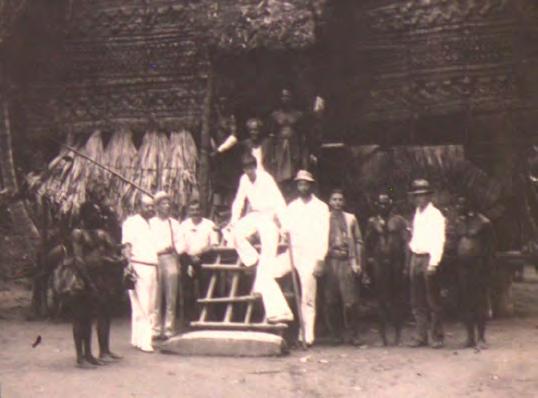
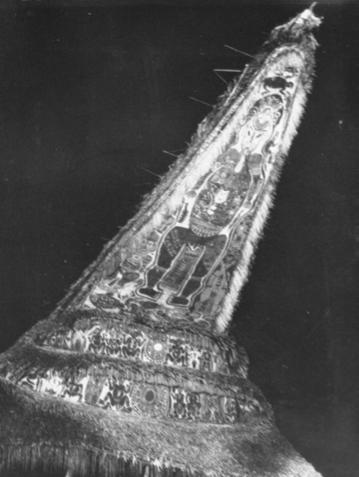
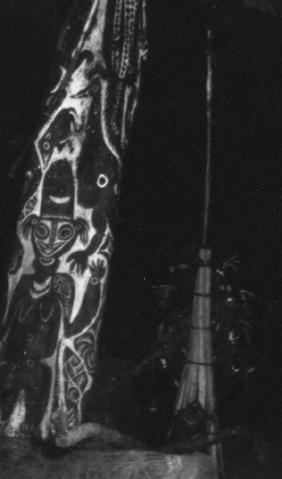
ABOVE: Painted house gable Kambot, photo by Karl Schmidt, Album
Z6page124 Courtesy Field Museum, Chicago. ABOVE CENTER: Interior painted posts, Kambot village, photo by Karl Schmidt,
Album Z6page124 Courtesy Field Museum, Chicago. RIGHT: Feather mosaics, photo by Fr.Kirschbaum, Courtsey Rautenstrauch-Joest
Museum, Köln RJM-3344 BELOW: Kambot House, photo by Dr. Moss, Courtesy The Metropolitan
Museum of Art
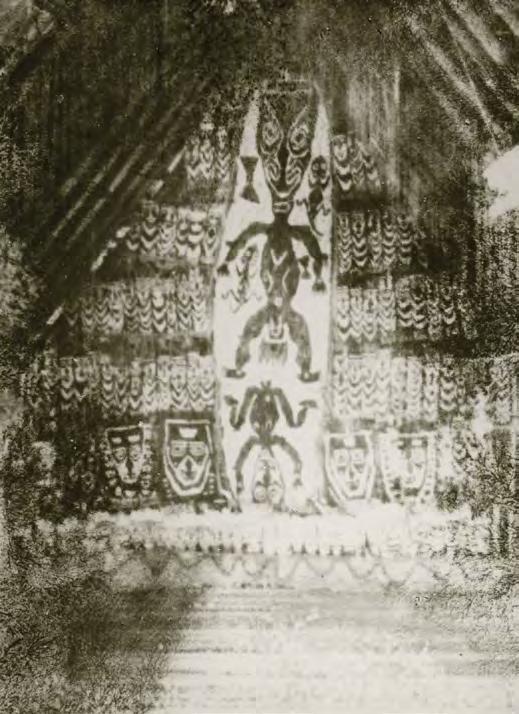
interior spaces held displays of figures, masks, and shields decorated and painted in numerous media and motifs. While no feather mosaics were found in this village, the abundance of sculpture, unique architecture, and paintings was a high point of the visit to the Sepik region. It is in Kambot village that Herre found this mask. In fact, the painting on the mask is clearly stylistically similar to the painting throughout the village. Diagonally positioned, almond-shaped eyes connect to the narrow, pointed, vertical nose carved in relief. The volumes of the positive shapes and voids are emphasized by delicate linear circles painted in white pigment. Faces, birds, crocodiles, and other clan designs are seen in the imagery of the painting in several Keram River villages.
The distances, obstacles, navigational difficulties, and other impediments did not hamper the results of the Crane Pacific Expedition. The documentation and visual records provide us with a glimpse through the mind’s eye of what those explorers saw, and we get a glimpse of those two days in May 1929 on the Keram River.
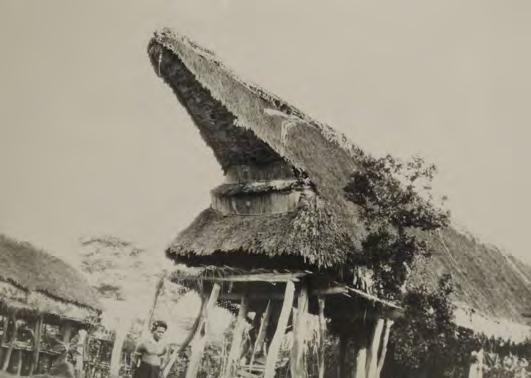
1 Field Museum Archives, Chicago. Director’s Papers, Expedition Correspondence, Cornelius Crane Expedition of Field Museum. Folder 2/18 Feb–July 1928. Letter from Raymond Wilbur 10 April 1928 to Dr. D.C. Davies Director Field Museum. 2 Biographical information was obtained from various sources including the Field Museum Archives, Chicago; and the Wilson Library, Western Washington University, Special Collections, Bellingham, Washington http://archiveswest.orbiscascade.org/ark:/80444/xv48403;and “Who’s Who in American History” vol.4, 1961–1968. Chicago. Marquis 1968. 3 Photos of the feather mosaic display are published in Brigitta Hauser-Schäublin. Kulthäuser in Nordneuguinea. Berlin. AkademieVerlag1989: 367 (Abb.117) and Waldmar Stöhr. Melanesien:. Schwarze Inseln der Südsee. Köln. Rautenstrauch-Joest-Museum für Völkerkunde der Stadt Köln 1971: 101 (Abb.177). The photos are flipped horizontally in each publication, and the image in Stöhr is darker with less detail.


15 Sawos Mei Mask, Masco Collection
Sawos culture, north of Middle Sepik River, East Sepik
Province, Papua New Guinea Collected pre-1915 by the German colonial Dr. Hans Ewald
Kersten (Inventory number 1641 painted in white on the mask’s reverse) Philip Goldman, London Bruce Seaman, Bora-Bora Wayne Heathcote, New York Masco Collection, Detroit Sotheby’s New York, 15 November 2002, lot 138 David Rosenthal, San Francisco Cathryn Cootner Collection, Sonoma Published in Island Ancestors: Oceanic Art from the Masco
Collection. 1994, no. 19, pages 66/67 Pre-contact, stone-carved, 19th century 15 ¼” (38.7 cm) in height
Mei or Mwai masks are classics of Oceanic art and one of the most iconic of Sepik River artifacts. This pre-contact example is one of the earliest I have encountered. The small nassa shells that would have adorned the surface are long gone, leaving the pure form of the mask underneath. There is an ancient, unadulterated feel to the composition that has been distilled into the basic piercing eyes that tail off towards the ears, the deeply pierced septum, and the nose that curves down below the chin tipped by an archaic bird’s head. The surface is dark brown with traces of paint remaining. There is not much information on Dr. Hans Ewald Kersten except that he began work in Madang (then FriedrichWilhelmshafen) on 24 July 1912. He transferred to Rabaul in August 1913, sent a shipment of ethnographica back to Germany in May 1914, and left New Guinea for good in June of 1915.
